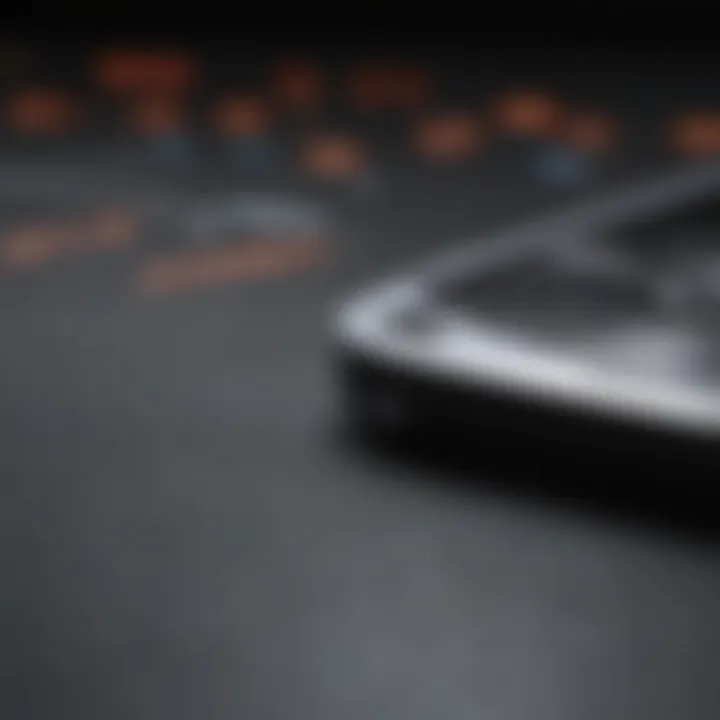Hold the Line Ringtone: An In-Depth Exploration


Intro
The exploration of the 'Hold the Line' ringtone is not merely a discussion about a catchy melody. It serves as a reflection of how music has diffused into our everyday lives, particularly through personal communication devices. Ringtones have transformed from simple alerts into cultural artifacts, and 'Hold the Line' exemplifies this evolution well.
In this article, we will delve into the background of the song and the artist, analyze its themes and musical structure, and consider its significant impact on both consumers and the telecom industry. The ringtone's popularity provides a glimpse into consumer behavior and the broader implications of technology in shaping our expressions.
Artist Profile
Biography and Background
Toto, the band behind 'Hold the Line', originated in Los Angeles in 1977. Comprised of talented musicians, Toto gained fame for its unique blend of rock, pop, and progressive elements. The group emerged during a time when rock was evolving rapidly. Their debut album, featuring 'Hold the Line', secured their status as significant contributors to the genres they worked within.
Major Influences and Inspirations
The band was influenced by various genres including rock, jazz, and classical music. Musicians like Steely Dan and The Beatles shaped their sound. Their unique approach resulted in a rich tapestry of musical influences, which is evident in 'Hold the Line'. This song showcases their background, combining well-crafted melodies with intricate harmonies.
Song Analysis
Theme and Lyrics Breakdown
'Hold the Line' explores themes of love and perseverance. The lyrics convey a message of fidelity amidst challenges, emphasizing the importance of commitment. This theme resonates with listeners, adding to the song's broad appeal.
Instrumentation and Composition
The composition features a distinctive blend of guitar riffs, keyboard arrangements, and rhythmic precision. Instrumental sections are skillfully crafted, creating a signature sound for Toto. The balance of melodies and harmonies enhances the overall experience, making the song memorable.
"The song’s clever arrangement and lyrical depth elevate it beyond mere entertainment; it stands as a testament to Toto's artistic prowess."
The integration of rock elements with polished production elevates 'Hold the Line' from a simple tune to a revered classic. This has contributed to its enduring fame, making it a popular choice among ringtone selections.
Preamble
Music, in its many forms, shapes the experiences of our everyday lives. One fascinating intersection of music and technology is found within the realm of ringtones. Notably, the ringtone derived from Toto's song Hold the Line serves as an intriguing study case. This section introduces the importance of this ringtone in today's digital communication landscape and discusses various elements surrounding its role.
The Hold the Line ringtone is significant not only because of its immediate melodic recognition but also due to its historical context. Released in the late 1970s, the original song merges complex musical arrangements with relatable lyrical themes. As technology evolved, so did the ways we use music. The adaptation of songs like Hold the Line into ringtones represents a natural progress in how we express identity within a mobile-first era.
There are numerous benefits associated with the use of ringtones such as Hold the Line. They offer a means of personalization in communication, allowing people to convey their tastes and preferences even before they pick up the phone. Additionally, this phenomenon presents a unique lens into consumer behavior and trends in mobile technology.
Moreover, the cultural significance of Hold the Line as a ringtone reveals insights about societal shifts. In many ways, these melodies become a soundtrack to our lives, encapsulating moments and memories. Understanding this interplay of music and personal expression is vital for music enthusiasts, aspiring musicians, and students of music alike.
Ultimately, this introduction sets the stage for a deeper exploration into the origins, impact, and enduring appeal of the Hold the Line ringtone and its place in both music history and modern communication.
Historical Context of 'Hold the Line'
The historical context of 'Hold the Line' is crucial to understanding its significance within the realms of music and technology. This section will unveil the layers that contribute to its impact, particularly within the landscape of popular culture and communication.
Origin of the Song
'Hold the Line' is a classic song by the American rock band Toto, released in 1978. The song was part of their debut album and quickly gained popularity due to its catchy melody and relatable lyrics. The band was formed by experienced musicians, each bringing a unique influence to the sound. David Paich and Jeff Porcaro were vital to the song's creation, combining elements of rock, pop, and jazz in a way that was unique for the time. The lyrics explore themes of perseverance and the complexities of love, resonating with many listeners. This blend of personal narrative and musical innovation played a pivotal role in establishing Toto as a key player in the music scene of the late 1970s.
Cultural Significance in the Seventies
In the 1970s, music was a medium of expression and cultural commentary. 'Hold the Line' emerged during a transitional period, where rock music was evolving and embracing diverse influences. The era was marked by the rise of FM radio and the burgeoning music video scene, setting the stage for songs that would define generations. This particular song became emblematic of its time, representing both optimism and the struggle of maintaining relationships in a rapidly changing world. Its success underscored the importance of well-crafted songs in connecting with listeners on an emotional level. Moreover, 'Hold the Line' received significant airplay, ensuring its place on the charts and contributing to Toto's reputation as a formidable band.


Legacy of the Song
The legacy of 'Hold the Line' extends beyond its initial release. Over the years, it has been covered by various artists and integrated into numerous cultural events, establishing itself as an anthem of sorts. Its inclusion in films, television shows, and commercials has helped maintain its relevance, especially with new generations discovering the track through modern media platforms. The song remains a staple for cover bands and is often played at live music venues, showcasing its enduring appeal. The technical components that made the song distinctive, such as its harmonic structures and instrumental solos, continue to influence aspiring musicians. Additionally, the debate regarding its classification as a timeless rock classic underscores its significance in music history.
"'Hold the Line' is not just a song; it's a reflection of an era and a bridge between generations of music lovers."
Understanding the rich historical context of 'Hold the Line' enhances our appreciation of it as a ringtone. Its journey from a chart-topping hit to a personal soundscape for listeners encapsulates the broader narrative of how music intersects with daily life.
The Rise of Ringtones
The emergence of ringtones marked a significant evolution in mobile technology and communication. Ringtones transformed from a simple alert sound into a form of self-expression and cultural identity. This shift reflects broader social dynamics and consumer preferences that drive innovation in the mobile industry today.
Evolution from Monophonic to Polyphonic
The evolution of ringtones began with monophonic tones that featured simple melodies, often limited to a single note at a time. These basic sounds were sufficient for notifications, but they did not provide a personalized experience. With the advent of polyphonic ringtones, phone users experienced a shift in how music could be integrated into their mobile devices. Polyphonic ringtones allowed for multiple notes to play simultaneously, creating richer, fuller sounds that more accurately represented songs. This innovation brought a new level of sophistication to mobile communication tools.
The introduction of polyphonic ringtones made it possible for users to select snippets of popular songs, further bridging their personal taste with their technology. This shift elevated the status of ringtones beyond mere alerts; they became a way to showcase individuality. For instance, many people chose "Hold the Line" by Toto as their ringtone to express their musical preferences and connect with the nostalgia that the song evokes.
Impact of Mobile Technology
Mobile technology has played a crucial role in the rise of ringtones. The advancement of smartphones introduced not just better audio capabilities, but also platforms that made it easy for users to acquire and customize ringtones. With the ability to download music directly to devices, the ringtone market exploded. Music services began offering extensive libraries that included various genres and artists. This accessibility altered consumer behavior significantly. Users became more willing to spend money on ringtones as they recognized their value in personal branding.
Moreover, mobile operating systems like iOS and Android facilitated the integration of ringtones with personal contacts. This feature allowed users to assign specific tones to individual callers, enhancing the social experience of communication. Ringtones became tools for establishing connections, as the sounds could evoke memories tied to specific people or relationships.
Consumer Demand for Customization
Consumer demand for customization has driven the evolution of ringtones into a multi-faceted market. As users seek distinctive ways to express themselves, ringtones have become an essential means of demonstrating personality. Some people prefer well-known songs, while others opt for unique or obscure tracks that set them apart. This customization extends beyond just the choice of music; users often mix, trim, and edit audio clips to create personalized versions.
The "Hold the Line" ringtone exemplifies this trend, as it allows fans of the song to carry a piece of music history in their pocket. The widespread accessibility of apps and services that facilitate ringtone creation and modification has empowered users to engage with music on a deeper level.
In summary, the rise of ringtones has reshaped how individuals interact with mobile technology, turning simple notifications into powerful expressions of identity and community. The continuous demand for customization and the technological advances that support it indicate that ringtones will remain a relevant aspect of our digital communication landscape.
'Hold the Line' as a Ringtone
The adaptation of the song "Hold the Line" into a ringtone represents a significant overlap between music, technology, and personal expression. This section explores how this iconic track has transitioned into a digital format that can convey individuality and style. The success of ringtones, particularly this one, hinges on nostalgia and the emotional connection listeners have with the song. Ringtones now serve as more than just sounds for incoming calls; they have evolved into personal statements. As such, the choice of ringtone often reflects aspects of one's personality or preferences, making the popularity of "Hold the Line" worth examining in this context.
Adaptation of the Song for Ringtone Format
Adapting "Hold the Line" for ringtone format involves several key factors. Firstly, the process requires distilling the song into its most recognizable and impactful segments. This means identifying short excerpts, generally lasting a few seconds, which preserve the essence of the original track. The challenge lies in maintaining the song’s emotional and aesthetic qualities while ensuring that it fits within the limitations of mobile technology.
Furthermore, certain elements like rhythm and melody are crucial in this adaptation. The iconic guitar riffs and catchy hooks are essential. Consumers want ringtones that not only capture their attention but also evoke feelings and memories. By transforming these specific parts of the song into a concise format, the ringtone version can resonate with users, enabling a lasting connection to the music they love.
Technical Aspects of Ringtone Production
The production of a ringtone involves several technical considerations. The first step is to select a part of the song that is both recognizable and sonically pleasing. Once selected, the audio needs to be processed to fit specific ringtone formats. Common formats include MP3 and AAC, which are compatible with most mobile devices.
Next, audio editing software is utilized. Programs like Audacity or Adobe Audition allow producers to trim, loop, or modify the sound wave. It may also be necessary to adjust the volume levels to ensure clarity when played back on various devices. These technical steps are essential for achieving high-quality ringtones that do justice to the original song while being functional on everyday mobile devices.
Importantly, encoding and compression are also integral to this process. High-fidelity music files might lose some quality when compressed for ringtone use. Hence, skilled technicians pay careful attention to this so the final product is still enjoyable.
Integration into Mobile Devices
Integrating the "Hold the Line" ringtone into mobile devices involves an understanding of the ecosystem of smartphones and their operating systems. Ringtones need to be easily accessible for users who wish to download or purchase them. Both iOS and Android have built-in options for selecting custom ringtones, but the method for integrating them can differ.
For iOS devices, users generally download the ringtone from a platform like iTunes before syncing it with their phone. In contrast, Android users might have the option to download ringtones directly from the internet or through specific apps. This accessibility plays a significant role in the ringtone's overall popularity.


Cultural Impact of Ringtones
The cultural impact of ringtones is significant in the broader context of music, technology, and communication. Ringtones serve as a personal identifier in a crowded world. They represent individual choices, preferences, and even social status. In many ways, ringtones have evolved beyond simple notifications of an incoming call; they embody a medium of self-expression and public identity.
Ringtones as a Form of Identity
Ringtones reflect the personality and interests of individuals. For some, it is a signature sound that speaks volumes about their taste in music. Those who choose 'Hold the Line' as their ringtone may enjoy its nostalgic elements or the artistry of Toto.
In fact, selecting a ringtone can be akin to wearing a favorite band T-shirt. It communicates something about one's identity to others. Some individuals prefer popular songs, while others might go for obscure melodies. This diversity showcases personal tastes. Ringtones often define social roles; youth might choose current pop hits, while older generations opt for classic rock or ballads.
Ringtones play a role in interactions too; they can evoke specific emotions, reminding people of certain memories or relationships. Thus, they can drive conversations and create bonds between people who share similar interests in music.
Ringtone Trends in Popular Culture
Over the years, ringtones have made their mark on popular culture. How they evolve often reflects broader societal changes. Initially, simple and monophonic tones dominated. With advancements in technology, the industry saw a shift towards polyphonic ringtones, which allowed a richer soundscape.
As streaming services gained popularity, many began using snippets from current hits as ringtones. This trend led to an increase in viral sounds from social media platforms, connecting various forms of media. Such development indicates how digital culture shapes consumer behavior.
Key trends include:
- Synthetic Beats: Many ringtones now feature synthesized sounds or beats that replace traditional melodies.
- Song Clips: Users often select sections from popular songs because these provide instant recognition.
Ringtones and Social Interaction
The way ringtones influence social interaction is fascinating. They often embed themselves into social dynamics, serving multiple functions. First, they can break the ice in conversations, as people often comment on the ringtones they hear in public places. A well-chosen ringtone may resonate with someone nearby, triggering discussions about music preferences or shared cultural references.
Second, ringtones shape social norms. Certain settings may dictate the appropriateness of ringtone volume or type. For instance, in formal environments, a loud or humorous ringtone may be viewed as disruptive. It highlights the need for individuals to consider their surroundings when selecting ringtones.
To summarize, the cultural implications of ringtones are intricate and multifaceted. They serve as tools for self-expression, mirrors of societal trends, and facilitators of human interaction. In a world where digital communication is paramount, ringtones remain a relevant and evolving form of identity.
"Ringtones are not just sounds. They are declarations of self in an interconnected world."
Ringtones continue their journey into our digital lives, reflecting deeper connections to music and identity.
Marketing and Ringtones
The relationship between marketing and ringtones is critical for understanding the wider implications of mobile technology in shaping consumer behavior. Ringtones serve not only as personalized audio signatures but also as a reflection of trends influenced by marketing strategies. The rise of the mobile phone as a primary mode of communication opened up new avenues for brands to engage with consumers. This section unpacks the tactics employed by telecom companies and examines how the landscape of music, licensing, and consumer purchasing behaviors have evolved to adapt to the growing demand for ringtones.
Strategies Employed by Telecom Companies
Telecom companies have played a pivotal role in the ringtone market, utilizing various strategies to enhance revenues through this niche. Major players recognized the potential of ringtones as an extra source of income beyond standard mobile services. They implemented strategies such as:
- Exclusive Offerings: Collaborating with artists to provide exclusive ringtones not available elsewhere, enticing consumers to purchase through their platforms.
- Bundling Services: Combining ringtones with data or call plan packages, making it convenient for users to select and purchase ringtones easily.
- Promotional Campaigns: Utilizing social media and other advertising channels to highlight popular ringtones like "Hold the Line", appealing to both nostalgia and contemporary tastes.
These strategies have been vital in creating a robust market for ringtones and enhancing brand loyalty.
The Role of Music Licensing
Music licensing is a cornerstone of the ringtone business model, determining how the music can legally be used in products like ringtones. Companies like BMI and ASCAP assist creators and publishers in licensing their music for different uses. However, there are key challenges and considerations:
- Revenue Sharing: Artists and songwriters typically receive a royalty every time their music is used as a ringtone. Negotiating these agreements can be complex but necessary for ensuring fair compensation.
- Licensing Models: Different approaches exist including mechanical licenses for reproduction and synchronization licenses for integrating music in various formats. This impacts how easily and widely a song can be adapted into a ringtone.
Without effective licensing arrangements, the ringtone market would struggle to provide the variety of options consumers desire.


Consumer Behavior and Purchasing Patterns
Understanding consumer behavior regarding ringtones reveals fascinating insights into trends and preferences that drive purchasing patterns. Ringtone sales have evolved, reflecting changes in technology and user expectations.
- Preference for Personalization: Consumers prioritize unique ringtones that reflect their tastes and identities. This trend indicates a shift from generic tones to music that resonates personally, such as classics like "Hold the Line".
- Accessibility and Price Points: The price range for ringtones varies, from a few cents to several dollars. Apps and platforms with competitive pricing and subscriptions have influenced how consumers perceive value in purchasing ringtones.
The intersection of music and personal expression plays a significant role in consumer choices, further amplifying the importance of marketing strategies aimed at this demographic.
"Ringtones are not just sounds; they are a statement of identity and creativity in the digital age."
In summary, the marketing of ringtones is multifaceted, involving collaboration, licensing intricacies, and an intimate understanding of consumer dynamics. Collectively, these elements construct a rich framework for how ringtones, particularly those like 'Hold the Line', continue to adapt and thrive in the fast-paced world of mobile communication.
Future of Ringtones
The future of ringtones stands as a critical topic within the broader exploration of mobile communication and personal expression. As technology evolves, so too does the relevance of ringtones in daily life. Their role goes beyond mere notification sounds; they represent personal branding and individuality. Understanding the trajectory of ringtones helps illuminate broader trends in music and technology, which influence consumer behavior and communication styles.
Technological Innovations
Technological innovations will shape the future of ringtones significantly. Advancements in smartphone capabilities have already changed how we produce and use ringtones. For instance, the ability to customize ringtones with high-quality formats or even snippets from streaming services has expanded options for users.
Moreover, developments in artificial intelligence (AI) are likely to facilitate more unique ringtone creations. Apps may allow users to generate original sounds based on personal preferences or even AI-generated music. These innovations offer enhancements not only in sound quality but also in the way ringtones integrate with smart home devices, paving the way for interconnected audio experiences.
Changing Trends in Music Consumption
The landscape of music consumption is pivotal to understanding the future of ringtones. With platforms like Spotify and Apple Music dominating the music scene, users have access to a vast library of songs. This accessibility has shifted the focus from ownership to streaming. As a result, ringtones are likely to reflect the latest hits or niche tracks that align with personal tastes.
In addition, social media platforms encourage trends where popular sound bites become ringtones, often based on viral challenges or memes. These trends point to a dynamic interchange between how music is consumed and how it influences ringtone selections. The ingenuity to blend popular culture into personal sound choices reflects a significant shift in consumer behavior.
Potential for New Formats
Exploring the potential for new formats in ringtones opens a dialogue about the boundaries of what a ringtone can be. With the capabilities of devices expanding, ringtones may evolve into more than just short clips of songs. We could see formats that incorporate multiple layers, such as background sounds mixed with voice messages or user-generated phrases.
The integration of augmented reality (AR) in mobile technology may also lead to unique notifications tailored for specific environments, creating an auditory experience that feels bespoke. Ringtones might transform into an auditory signature that reflects one’s environment or mood, further enriching the personalization aspect.
The evolution of ringtones is not just about sound; it embodies cultural expression and individual identity in an increasingly digital world.
In summary, the future of ringtones holds promise for innovation through technology, changes in music consumption, and potential new formats. The landscape is poised to adapt, ensuring that ringtones remain relevant in a rapidly changing digital era.
Closure
The importance of the conclusion section in this article cannot be overstated. It serves as the final synthesis that ties together the various strands of analysis presented throughout the text. Recognizing the significance of 'Hold the Line' as a ringtone goes beyond mere nostalgia. It reflects how music interacts with technology and the ways in which it shapes personal expression in modern communication.
Summation of Key Insights
In summarizing key insights, we find that 'Hold the Line' is not just a song but a cultural artifact. Its adaptation into a ringtone has resulted from historical circumstances and technological advancements. The evolution of ringtones signifies a shift in how we perceive and interact with music, blurring the lines between artistic content and consumer product.
Key points include:
- Historical Significance: Originating in the 1970s, the song gained a following that extended into the ringtone market.
- Technological Evolution: Progress from basic monophonic tones to complex polyphonic renditions reflects the evolution in mobile technology.
- Cultural Impact: Ringtones like 'Hold the Line' symbolize personal identity and social interaction in an increasingly digital society.
The Enduring Appeal of Ringtones
The lasting allure of ringtones is multifaceted. Ringtones serve not only as alerts to incoming calls but also as a means of self-expression. For many, a ringtone is more than just sound; it is a statement about an individual's tastes and preferences.
The concept of customized ringtones can be summarized as follows:
- Personalization: Users gravitate toward ringtones that resonate with their personal experiences, memories, or favorite songs.
- Social Interaction: The choice of ringtone often provokes conversations and connections among peers.
- Cultural Resonance: Iconic songs, like 'Hold the Line', endure in popularity, affirming their importance in both music history and modern life.
"Ringtones redefine how we connect with music and each other in significant ways."
Ultimately, the enduring appeal of ringtones encapsulates a rich intersection of artistry, technology, and human connection, solidifying their place in both our personal and cultural landscapes.







